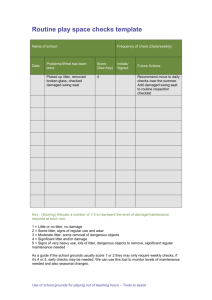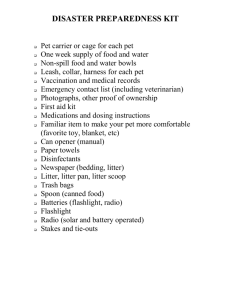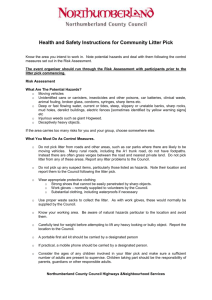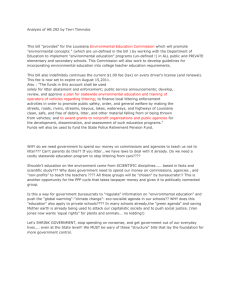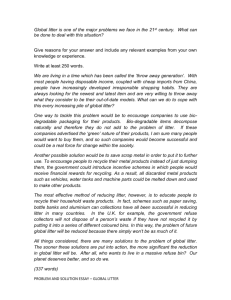Fact Sheet: Litter Surveys Made Easy
advertisement
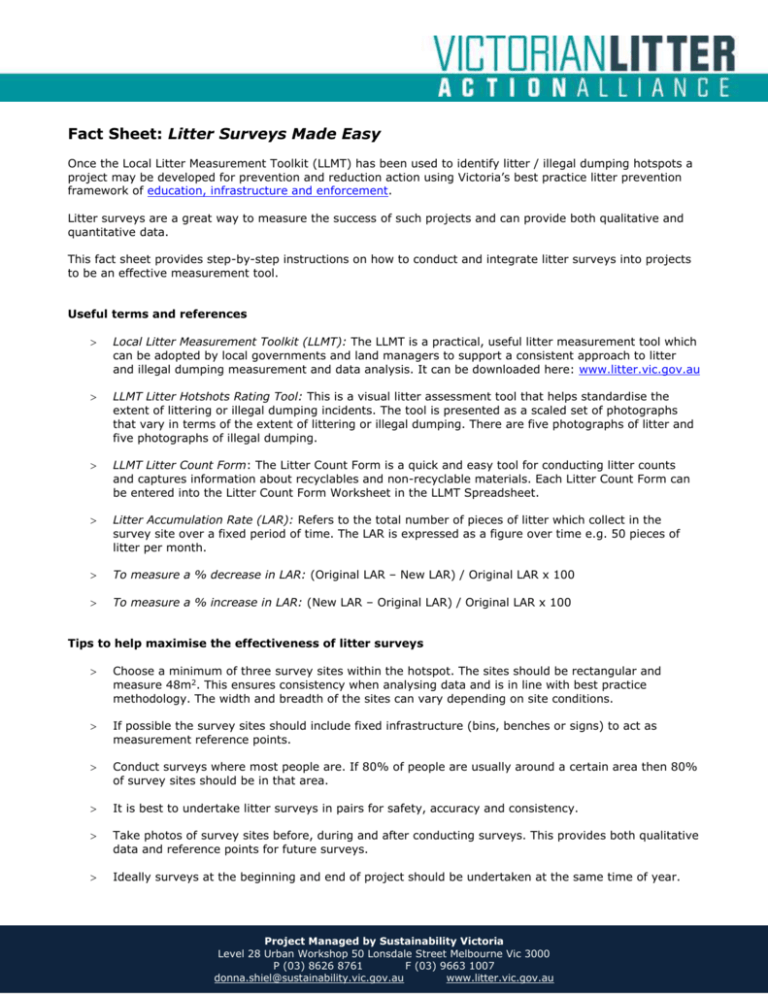
Fact Sheet: Litter Surveys Made Easy Once the Local Litter Measurement Toolkit (LLMT) has been used to identify litter / illegal dumping hotspots a project may be developed for prevention and reduction action using Victoria’s best practice litter prevention framework of education, infrastructure and enforcement. Litter surveys are a great way to measure the success of such projects and can provide both qualitative and quantitative data. This fact sheet provides step-by-step instructions on how to conduct and integrate litter surveys into projects to be an effective measurement tool. Useful terms and references Local Litter Measurement Toolkit (LLMT): The LLMT is a practical, useful litter measurement tool which can be adopted by local governments and land managers to support a consistent approach to litter and illegal dumping measurement and data analysis. It can be downloaded here: www.litter.vic.gov.au LLMT Litter Hotshots Rating Tool: This is a visual litter assessment tool that helps standardise the extent of littering or illegal dumping incidents. The tool is presented as a scaled set of photographs that vary in terms of the extent of littering or illegal dumping. There are five photographs of litter and five photographs of illegal dumping. LLMT Litter Count Form: The Litter Count Form is a quick and easy tool for conducting litter counts and captures information about recyclables and non-recyclable materials. Each Litter Count Form can be entered into the Litter Count Form Worksheet in the LLMT Spreadsheet. Litter Accumulation Rate (LAR): Refers to the total number of pieces of litter which collect in the survey site over a fixed period of time. The LAR is expressed as a figure over time e.g. 50 pieces of litter per month. To measure a % decrease in LAR: (Original LAR – New LAR) / Original LAR x 100 To measure a % increase in LAR: (New LAR – Original LAR) / Original LAR x 100 Tips to help maximise the effectiveness of litter surveys Choose a minimum of three survey sites within the hotspot. The sites should be rectangular and measure 48m2. This ensures consistency when analysing data and is in line with best practice methodology. The width and breadth of the sites can vary depending on site conditions. If possible the survey sites should include fixed infrastructure (bins, benches or signs) to act as measurement reference points. Conduct surveys where most people are. If 80% of people are usually around a certain area then 80% of survey sites should be in that area. It is best to undertake litter surveys in pairs for safety, accuracy and consistency. Take photos of survey sites before, during and after conducting surveys. This provides both qualitative data and reference points for future surveys. Ideally surveys at the beginning and end of project should be undertaken at the same time of year. Project Managed by Sustainability Victoria Level 28 Urban Workshop 50 Lonsdale Street Melbourne Vic 3000 P (03) 8626 8761 F (03) 9663 1007 donna.shiel@sustainability.vic.gov.au www.litter.vic.gov.au Conducting a full scale litter survey 1. Select survey sites within the hotspot and mark them out using survey markers and/or existing infrastructure. Take photos to use as a reference. 2. Use the LLMT Litter Hotshots Rating Tool to visually assess the amount of litter in the sites. Record this in the LLMT Litter Count Form. 3. Thoroughly clear all the litter from each survey site placing each sites litter into its own bag to sort and count in a clean area. 4. Record litter data using the LLMT Litter Count Form. Use one form per survey site. Enter the data collected into the LLMT Litter Counts Worksheet in the LLMT Spreadsheet – this is the first count*. 5. Revisit the survey sites within a specific timeframe, typically one week to one month, to conduct the accumulation count by repeating steps 2 to 4. 6. Establish the LAR by finding the total amount of litter that has accumulated in the site since the first count. *Instead of clearing all the litter it can be counted in-situ and recorded on the LLMT Litter Count Form. After the count is complete then clear away all the litter. This is known as a visual survey. Integrating this measure into projects Example project aims: To reduce the LAR by 20% and move from a Litter Hotshots Rating of 3 to 1. OR To reduce the LAR from 50 pieces per month to 25 pieces per month and move from a Litter Hotshots Rating of 4 to 2. Surveys can be conducted at the beginning, middle and end of the project to support the aim. Make sure that the time between each of the first counts and their accumulation counts is the same: 1. Initial count: Set baseline LAR by conducting a first count and accumulation count before the project launch. 2. Middle count: Conduct another first count and accumulation count during the project to track progress. 3. End count: Conduct another first count and accumulation count at the end project to compare with the baseline LAR. Project Managed by Sustainability Victoria Level 28 Urban Workshop 50 Lonsdale Street Melbourne Vic 3000 P (03) 8626 8761 F (03) 9663 1007 donna.shiel@sustainability.vic.gov.au www.litter.vic.gov.au

